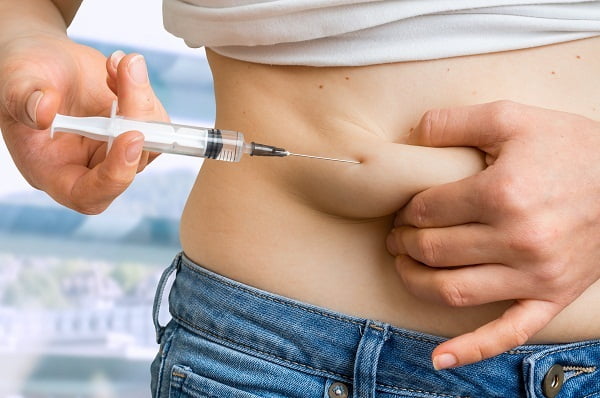
The treatment for all types of diabetes commonly focus on controlling and maintaining normal blood sugar levels and also to control symptoms to some extent so as to prevent health problems that develop later with this disease.
Managing the Diabetes
The treatment of diabetes focuses on achieving a good health and in maintaining a healthy body weight by working on the following three areas. These also help in managing the diabetes.
A balanced and healthy diet with a proper meal timing
The diet plan is different for different individuals depending upon diabetes type and the weight of the person to achieve the goal of maintaining normal blood sugar level and healthy weight or BMI so as to avoid future complications related to this disease.
A dietician helps in making your diet plan and tell about what, how much and when to eat according to one’s food preferences and lifestyle. This helps in knowing the proper diet for a person to treat diabetes and avoid the symptoms.
The diet plan is focused on taking more vegetables, fruits and whole grains i.e., fiber-rich high nutritional and low fat and calories food and also to cut down on sweets, animal products and refined carbohydrates.
Sweets and sugary food is allowed to take once only if they are included in your diet by the dietician.
A balanced diet is important for people who have diabetes. Balanced intake of carbohydrates, fats, proteins and vitamins help you to keep blood sugar level normal and also to control being overweight which is essential to overcome diabetes complications in future.
Your diet should not contain more than 7% of saturated fats and you should focus on avoiding trans fats as well.
Following things should be considered for a proper diet to manage diabetes conditions.
- One should increase consumption of high-fibre foods, such as cereals, beans, lentils wholegrain bread and fruits and vegetables.
- Avoid full cream milk and choose skimmed or low fat milk and yoghurts.
- Milk products and fatty foods such as ghee, butter, and coconut oil should be avoided and replaced by low fat vegetable or rice bran oils.
- Processed meat such as sausages should be avoided and lean meat and fish should be taken in replacement.
- The food should be grilled or baked instead of fried or cooked in oil.
- Avoid fast and junk foods such as pizza, chips, burgers, pasties, mayonnaise, samosas and poppadoms.
Exercise and physical activity
Regular exercise and physical activities are needed for everyone to maintain healthy weight and healthy life. Exercise and physical activities are also vital parts to treat and control diabetes symptoms. Read about diabetes symptoms.
The exercise program is chosen after discussing with the doctor. For both diabetes types, this will help in controlling blood sugar level and improving insulin sensitivity in the body, i.e., body needs less insulin for sugar transport into cells.
Physical activities are decided on the basis of one’s interest and lifestyle by discussing with doctors. Various physical activities that may be considered include swimming, walking, biking, etc. These activities should be started slowly and increased gradually.
During an exercise, if your blood sugar level decreases, you should stop exercising and take snacks and drinks containing carbohydrate and wait for 15 minutes. Then, check your sugar level again and if it is still low, take carbohydrates again to normalize your blood glucose level.
For both types of diabetic people, exercise helps in lowering the chance of getting stroke or heart attack and also improves circulations in the body. Read about various types of diabetes.
Exercise also relieves stress. People with diabetes are encouraged to do aerobic exercise such as walking, cycling with moderate intensity for at least 150 minutes each week.
Strength training includes strengthening of muscles such as legs, hips, back, abdomen, chest, arms and shoulders. This should be done at least twice a week.
Weight management
Maintaining a proper BMI is vital to control symptoms of diabetes to get worsen at later stages of disease and also to prevent rapid disease progression.
An overweight or obese person who has Body Mass Index (BMI) of 30 and above should do exercise and physical activities to lose weight.
Intake of calories should be checked to reduce the weight.
The weight loss program should be continued until you achieve your maintained BMI or healthy range of BMI which is:
- 18.5-24.9kg/m² – for the general population
- 18.5-22.9kg/m² – South Asian or Chinese origin people – south Asian includes people from India, Bangladesh, Bhutan, Nepal, Pakistan, Indian-Caribbean, Maldives and Sri Lanka.
If anyone has BMI of 30kg/m² or more, a structured weight loss programme is needed. This program should form part of an intensive lifestyle change programme.
The above methods are essential to treat all types of diabetes and prevent the symptoms from worsening over a time period during the disease progression.
Treatment for type 1 and 2 diabetes
The treatment for type 1 and 2 diabetes, besides above diabetic management options, include medication, sugar monitoring and insulin therapy.
Medications for diabetes treatment
Medicines are sometimes prescribed by doctors to treat diabetes. Some medicine stimulate pancreas to release insulin and some inhibit release and production of glucose from the liver.
Some medicines block intestinal enzyme action that break down carbohydrates or block action of stomach and make tissues more insulin sensitive.
Metformin is the first medicine generally prescribed for type 2 diabetes.
Insulin therapy
Insulin helps in lowering the high blood sugar level. Many types of insulin are available in the market such as rapid-acting insulin, long-acting insulin, and some intermediate options depending upon the need of the patient and doctor’s prescriptions.
Insulin therapy is needed by people with type 1 diabetes and some of gestational and type 2 diabetic people also need this therapy to survive.
Insulin is not taken orally as stomach enzymes interfere with the action of insulin. Insulin is injected in the body through injection or insulin pen (device looks like large ink pen).
An insulin pump is also used to inject insulin inside the body. This pump is of the size of a cell phone worn outside the body and a tube connects the insulin reservoir to a catheter that’s inserted under abdominal skin.
A tubeless pump is also available now which works wirelessly. The insulin pump is adjusted and programmed to pump or dispense specific amount of insulin depending upon activities, meals and blood glucose level.
Many types of insulin which works differently are available in the market such as:
- Insulin glulisine (Apidra)
- Insulin detemir (Levemir)
- Insulin isophane (Humulin N, Novolin N)
- Insulin aspart (Novolog)
- Insulin lispro (Humalog)
- Insulin glargine (Lantus)
Maintaining blood sugar level
The blood glucose level should be checked depending upon the treatment plans and if someone is on insulin, he or she should be checked multiple times a day.
A careful monitoring of the blood sugar level helps to keep blood glucose level under control. People who are receiving insulin therapy also monitor their blood sugar level with glucose monitor continuously.
- Sometimes the blood sugar levels may change unpredictably even when managed carefully. In this situation diabetes treatment team helps in learning how the blood sugar level changes in response to the various physical activities, illness, alcohol, stress, and the food you consume.
- Doctors also recommend regular A1C testing to measure average blood glucose level in the past 2 to 3 months. The A1C testing shows effectiveness of your diabetes treatment plan. Increased A1C level indicates change should be needed in diabetes treatment plan. Read more about diabetes diagnosis and testing.
Pancreas transplantation
For some people with type 1 diabetes, pancreas transplantation may be one of the treatment options. With successful pancreas transplantation, one is not needed to have insulin therapy. But transplantations are risky and are not always successful.
One may need immune-suppressing drugs for lifetime to prevent organ rejection. These immune-suppressant drugs may have serious side effects on your body which include higher risk of infection, cancer and organ injury.
As side effects of these drugs after transplantation are more serious than the diabetes treatment, transplantation option is only applicable to people with uncontrolled diabetes or for those who need kidney transplantation also.
Bariatric surgery
It is a weight loss surgery. Although it doesn’t benefit everyone with type 2 diabetes, but a person with type 2 diabetes and BMI more than 35 may benefit from it.
In 55-95% people, the blood sugar level gets normal after this surgery depending upon the procedure performed. Surgeries in which a portion of small intestine is bypassed shows more effect on the blood sugar level than any other bariatric surgeries.
Drawbacks of the surgery and effects on the body are not known much, but some drawbacks include the risk of death and high cost of surgery. Also, a change in lifestyle is required and there may be long-term complications such as osteoporosis and nutritional deficiencies.
Gestational diabetes treatment
During pregnancy, it is essential to keep check on your blood sugar level to keep you and your baby healthy and prevent any complications during delivery.
Monitoring blood glucose level by insulin and oral medication in addition to a healthy diet and exercise is beneficial during pregnancy to avoid and treat gestational diabetes.
During labor, your blood glucose level is monitored by healthcare providers. If the blood glucose level is high, your baby releases high levels of insulin which helps in lowering blood sugar level right after birth.
Many women with type 2 diabetes alter their treatment and require insulin therapy during pregnancy as cholesterol-lowering medications and blood pressure drugs can’t be used during ppregnancy.






